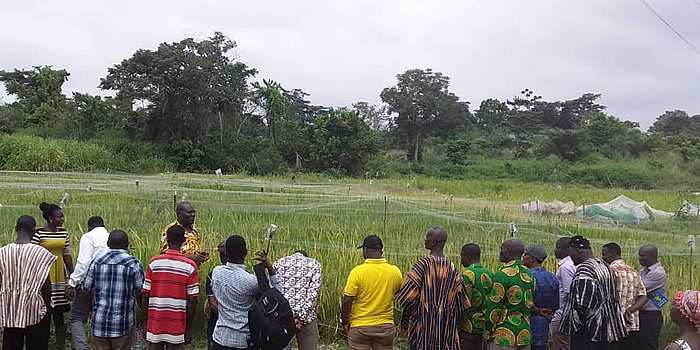

The population size and its age-sex composition have implications for the wellbeing of the people in the district. Population change is mainly due to fertility, mortality and migration levels which are also influenced by age-sex composition
Population size, structure and composition
The population of the district, according to the 2010 Population and Housing Census, is 65,402. Females constitute 52.6 percent and males represent 47.4 percent. More than half (52.8%) of the population is rural. The district has a sex ratio of 90.0. The population of the district is youthful (49.0%) depicting a broad base population pyramid which tapers off with a small number of elderly persons (4.9%). The total age dependency ration for the District is 96.8, the age dependency ratio for males is higher (104.0) than that of females (90.6).
Population Projection (2017-2021)
It is projected that the population of the District with a growth rate of 3.5 percent would increase from projected population figure of 83,559 in 2017 to 96116 by 2021. The projected annual population of the District from 2014 to 2017 is indicated in Table 1. 12.
There would be the need therefore to put in place socio-economic infrastructure programmes to take care of the increasing population.
Sex-age structure
About 42.5 percent of the population is in the 0-14 year’s age group, 50.8 percent are in the 15-64 years age group and the remaining 6.7 percent are in the 65 years and older year age group. Among the male population 46.1 percent are in 0-14 year age group, 49.0 percent are 15-64 years of age and 4.9 percent are 65+ years of age; their female counterparts are 39.3 percent, 52.4 percent and 8.3 percent, respectively. In the rural locality, 43.1 percent of the population are in 0-14 year age cohort compare to 41.8 percent of their urban counterparts; 50.3 percent are 15-64 years of age compared to 51.4 percent in that age group among the urban population; and 6.6 percent are aged 65 older year group compare to 6.8 percent among the urban population in that age group.
Sex ratio
The sex ratio for the district is 90.0 males to 100 females. This means that for every 100 women, there are 90 males. There are more males among the population aged 0-19 years as depicted by sex ratios of over 100 as follows: 0-4 years of age 102.7, 5-9 years of age 108.5, 10-14 years of age 105.5.and 15-19 years of age 106.0. The sex ratio are below 100 for the age groups 20-24 years and higher indicating that females outnumber their male counterparts.
Dependency ratio
Age dependency ratio refers to the ratio of people in the “dependent” ages (those under 15 years and those 65 and older) to those in the working age population (15-64 years). The age-dependency is often used as an indicator of the economic burden the working age productive portion of a population should carry even though some people defined as “dependent” are producers and some people in the “productive” ages are economically dependent (Population Handbook, 2011).
The age dependency ratio is 96.8 for the district which is higher than the regional average of 72.5. There is a slight difference in the estimates for males (104.0 and females (90.6). The age-dependency ratio of urban locality is 94.4 and that of the rural locality is 98.9.
Population Pyramid of Age-Sex Structure
A population pyramid shows age-sex structure of a population and the shape is influenced by the levels of fertility, mortality and migration. Figure1.10 shows population pyramid of the Sekyere Kumawu district. Females dominate in the district except for age groups (0-4 years, 5-9 years, 10-14 years, and 15-19 years) where males dominate. The broad base of the pyramid indicates a youthful population of many children and youth. The shape narrows from age 50-54 and shrinks significantly from age 85-89 and older which gives it the conical shape.
The level of reduction in the population is greater among males especially from the age group 15-19 years to 20-24 years. This situation applies to the females from the age group 10-14 years to 15-19 years.
The shape of the pyramid (broad base and narrow at the top) is indication that the district has a youthful population. About 53.1 percent of the population is under 20 years. This has implications for policy planning and provision of social amenities, such as, educational facilities, recreational and health facilities. This age structure depicts a built-in momentum for growth of the population. Thus, when those currently under 15 years eventually reach reproductive age, there will be a rapid population growth. However, if the socio-economic potentials of the youth are properly harnessed and directed through quality education, training and skills development, they would contribute tremendously to accelerate the development of the district and Ghana as a whole. Furthermore, the broad base of the population pyramid also implies that there are few people working to support a larger population who are under 15 years of age as well as those 65 years and older.
Fertility, Mortality and Migration
The levels of migration, fertility and mortality determine the population growth of an area. This section looks at fertility, mortality and migration in the district.
Fertility
Fertility is the number of live births a woman could have during her entire reproductive age (15-49 years). It refers to the actual production of offspring, rather than the physical capability to produce, which is fecundity. Fertility level is influenced by many socio-economic factors, such as locality, nutrients and education.
Total Fertility Rate (TFR) is the average number of children that would be born to a woman by the time she ended childbearing if she were to pass through all her childbearing years conforming to the age-specific fertility rates of a given year. General Fertility Rate (GFR) is the number of live births per 1,000 women aged 15–49 years in a given year. Another measure of fertility is the Crude Birth Rate (CBR) which indicates estimated total average births per 1,000 people. The rate is considered crude since the population is not at risk of giving birth (that is, all men and women outside the childbearing ages) is included in the calculation as denominator.
Table 1. 14 depicts the reported total fertility rate (TFR), general fertility rate (GFR) and crude birth rate (CBR) for the Sekyere Kumawu district in 2010. The district has a total of 15,021 females aged between 15-49 years, the reproductive years of most females. They represent 43.6 percent of the female population in the district.
The district recorded 1,913 births in the last 12 months preceding the Census Night by females aged 15-49 years old. The total fertility rate is 4.4 births per woman. This means that if females in the district are to experience childbirth throughout their reproductive years then each female is likely to have an average of four (4) children by the end of her childbearing age. The total fertility rate in the district of 4.4 is higher than the regional TFR of 3.3, and it is one of the districts with a high rate in the region.
The Sekyere Kumawu district has a general fertility rate of 127.4. This is much higher than the regional average of 96.4. The crude birth rate is 29.2, which is also higher than the regional rate of 25.7.
Children Ever Born and Children Surviving
Table 2.4 shows that, the 20-24 years age group is the prime age of reproduction even though those in the 12-14 and 15-19 age group are ripe for reproduction, the total number of children ever born in both age groups (446) is less than that of the 20-24 years age group (2,655).
The children ever born are 74,915 and proportion of males is slightly higher (50.1) than that of females (49.9%). Females aged 60 years and older had given birth to the highest proportion (33.1%) of the children ever born. On the other hand, those aged 12- 14 years has less than one percent of children ever born.
Source Ghana Statistical Service, 2010 Population and Housing Census
A total of 64,341 or 85.9 percent of 74,915 children ever born by females aged 12 – 49 years in the district survived. This means that the survival rate for the district (85.9) is slightly lower than that of the region (90.8). In terms of sex of the surviving children, the percentage of males is slightly lower (49.8%) than that of females (50.2%). Female children have higher survival rate (86.4) than their male counterparts (85.3). Females in the age group 12-14 years have the highest children survival rate (100.0%) and the lowest survival rate is among those in the age group 60 years and older. The number of children surviving increases as age increases.
Mortality
Table 1.16 presents deaths that occurred in households and crude death rate in the Sekyere Kumawu district. A total of 681 deaths occurred in households in the district with a crude death rate of 10.4 deaths per 1,000 people. This is higher than the regional crude death rate of 5.8. The district has the highest CDR in the region. Total population, deaths in households and crude death rate in Sekyere Kumawu District and Ashanti Region, 2010.
Causes of death
About 6.8 percent (one of the lowest in the region) of deaths in the district were as a result of accidents, violence, homicide or suicide and the remaining 93.6 percent were caused by other factors. The regional percentage of deaths as a result of accidents, violence, homicide or suicide is 11.9 percent.
Age-specific death rate
Figure 1.11 shows the death rate among the age groups in the district. The death rate among female children (under age 5 years of age) is higher compared with that of male children (1.4). At age cohort 25-39 years, the death rate among males is very high as compared with that of their female counterparts, thereafter, the male death rate starts to rise steadily as age increases whiles that of females occasionally increases at ages 40 - 44 years, 60 – 64 years and 65-69 years. The district experiences a higher male death rate than females from age 15 years upward, an indication of low life expectancy among males compared to females. Additionally, the difference in death rates for males and females from age 45 years and older is greater than the lower age groups.
Migration
A migrant is a person whose current place of residence is different from his or her place of birth or previous place of residence. There are two types of migration, namely, internal and external. Internal migration refers to the movement of people between geographical boundaries (administrative district) within national borders whiles external migration is the movement of people across geographical boundaries outside their national borders. Internal migration can be analysed in terms of intra and inter-regional movements. This is measured by information on place of birth as against place of enumeration.
Table 1.17 shows the distribution of the population by birthplace and duration of residence in the district. The total number of migrants enumerated in the district in 2010 is 14,794 and they represent 22.6 percent of the total population. The migrants born elsewhere in the region are 49.7 percent of the total, those born elsewhere in another region are 48.8 percent and those born outside Ghana are 1.5 percent. Of those born in other regions, the majority (2,656) were born in the Northern, Upper East (1,296) and Brong-Ahafo (1,078) regions.
In terms of duration of stay in the district, the majority of the migrants (52.4%) have spent less than five years in the district. Over half (55.6%) of the migrants born outside Ghana have spent less than five years in the district whereas 11.2 percent has stayed for more than 20 years. With regard to migrants born in the region, about 51.0 percent have spent over five years in the district.
Spatial Distribution of Population
Spatial distribution of population looks at the extent to which the population has been distributed in the various settlements in the district. This helps to determine where social services and infrastructural facilities are to be located. A critical look at the population distribution of the Sekyere Kumawu District reveals that the population is sparsely distributed with a larger proportion of the population residing in rural areas. According to the PHC 2010, 34,530 (52.8%) of the population lives in the rural areas and 30,872 (47.2%) are found in the urban areas of the District. The rural areas should however be considered more in planning for social services for the District.
Population Density
The population density talks about the average number of persons per land area. This is computed by dividing the total population of 65.402 by the total land area of 576.58sqkm. The district has a population density of 113.4 persons per squares kilometres. This is relatively higher than the National population density which stands at 103.4 persons per square kilometer. It is however relatively lower than the Regional density which pegs at 196.0 persons per square kilometer.
Household Size, Composition and Headship
Household Size
Table 2.8 shows household size by type of locality in the district in 2010. The district has t household population of 64,469 representing 1.4 percent of that of the region and the total household of 14,185 also accounting for 1.3 of the region. The average household size is 4.6 as compare 4.2 for the region. In the district, 30,290 (47.0%) of the total population live in urban locality compared to 34,179 (53.0%) in rural locality. About 51.6 percent of the households are in rural locality and 48.4 percent are in urban locality. The average household size for the urban is 4.5 and that of the rural is 4.7.
Date Created : 11/28/2017 3:34:44 AM











 facebook
facebook
 twitter
twitter
 Youtube
Youtube
 +233 593 831 280
+233 593 831 280 0800 430 430
0800 430 430 GPS: GE-231-4383
GPS: GE-231-4383 info@ghanadistricts.com
info@ghanadistricts.com Box GP1044, Accra, Ghana
Box GP1044, Accra, Ghana